
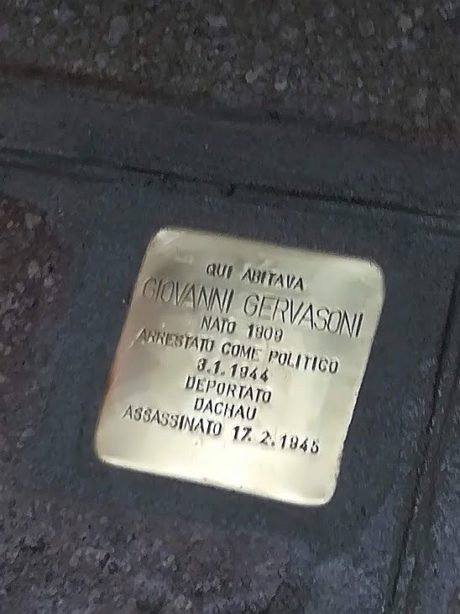
It may seem that I have decided to dedicate my blog to war memorials (and it does begin to seem that way), but I promise I will be broadening the scope and lightening the atmosphere very soon. But not quite yet, because the other morning I joined a large group of people who came to witness the installation of a so-called “stumbling stone” (Stolperstein, in German; pietra d’inciampo in Italian). At the risk of appearing frivolous, let me mention that plenty of Venice’s masegni, or paving stones, are fully capable of tripping people up all by themselves. It happens every day. But these are different.
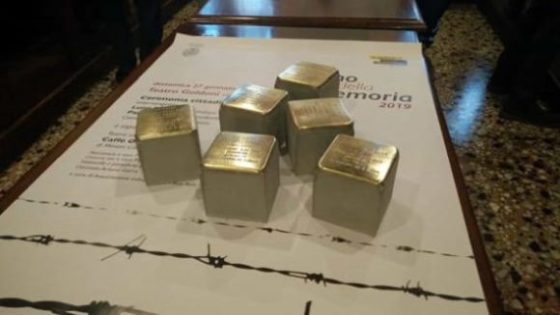
These “stones” are concrete cubes 10 cm (3.9 inches) on each side which bear a brass plate inscribed with the names of persons who were deported to the Nazi death camps; they are placed in the pavement in front of the house from which that person was taken (usually their home).
The majority of the victims were Jews, but you also risked deportation if you belonged to any of the following categories of non-ideal humans: Romani people, homosexuals, the mentally and physically disabled, Jehovah’s Witnesses, Mormons, blacks, members of the Communist or Social Democratic parties or the anti-Nazi Resistance, the Christian opposition (Catholic and Protestant), Freemasons, military deserters, International Brigades soldiers from the Spanish Civil War, escape helpers, conscientious objectors, capitulators, “habitual criminals,” looters, persons charged with treason, military disobedience or undermining the Nazi military, as well as Allied soldiers.
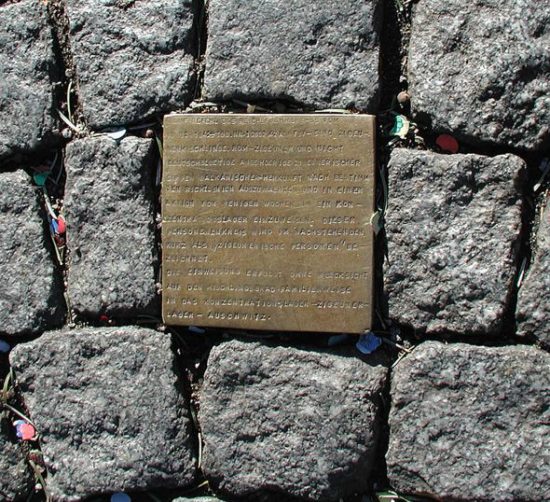
German artist Gunter Demnig began this project in 1992 — he hand-makes each “stone” — and as of October 23, 2018 there were 70,000 in more than 1,200 towns and cities across Europe. The first 12 in Venice were put in place in 2014; the city now counts 78 (including the Lido and San Servolo). For anyone wishing to see any (or all) of the stones in Venice, here is a map.
But why set the memorial into the street? One would expect to see it discreetly placed on a wall, perhaps, but the setting deliberately recalls an anti-Semitic saying in Nazi Germany when someone tripped on a paving stone: “A Jew must be buried there.” Furthermore, as Nazis destroyed Jewish cemeteries they would break up the tombstones, using the pieces in the sidewalks where countless passing feet would desecrate them.
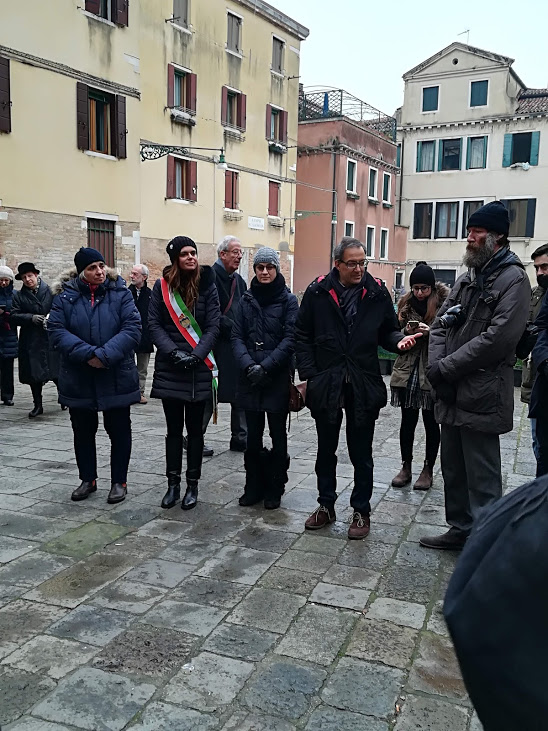

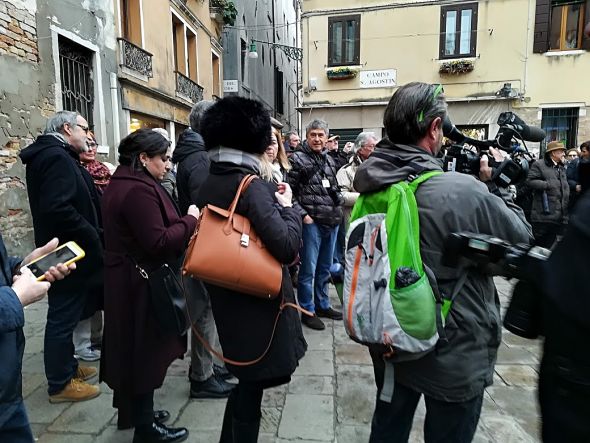
Giovanni Gervasoni was born into a modest Venetian family and studied to become an elementary school teacher. In 1930 he converted to Protestantism, joining the Waldensian Methodist community and working tirelessly in a group which distributed anti-Fascist publications.
Arrested as “a subversive” for the first time in 1932, he began a life of fleeing, hiding, and being under constant surveillance. “His political activity caused him to travel frequently between Venice and Padova,” recalled Alberto Bragaglia, a journalist and Waldensian, quoted in an article on nev.it. Bragaglia’s father, who was then an adolescent, told him that he remembered “a tall, lanky man who would suddenly appear at home and stayed as a guest for several periods of time.”
In 1935 he founded, with some men from the congregation, another group dedicated to the clandestine distribution of material from Giustizia e Liberta‘, an anti-Fascist Resistance group. Just a few months later, in April, he was arrested again and sent to the island of Ventotene, one of the regime’s best-known penal colonies for political prisoners. There he began, with fellow-prisoner Dr. Romola Quarzola, to try to secretly send anti-Fascist tracts to the mainland. Discovered, he was sent to prison in Rome and then Civitavecchia.
In December, 1938 he was sent to the island of Ponza, a prison island near Ventotene; after an extension of his sentence, he was finally liberated in July, 1943, the conclusion of eight years of incarceration. Undaunted, he returned to Venice and began to work as a partisan in collaboration with the Anglo-American forces. Arrested again on January 3, 1944, he was sent to Dachau and killed on February 17, 1945.

I hope this summary hasn’t bored you; I’ve given it to demonstrate the central point of all the thousands of “stones” across Europe. Gervasoni was only 36 when he died, having spent 15 years, roughly half his life, working against the Nazi-Fascist regime. What this small brass plaque represents, brightly and bravely, isn’t his death, but his life.

12 Comments
This posting exposes yet another horrendous example of man’s inhumanity. It’s painful to read but it’s important that the story be told so that these victims are not forgotten. Thank you.
Thanks so much for responding to all this (my post, the “stumbling stones” project, etc.). I do try to mitigate the pain of their loss by keeping my eye on how willing so many people were to risk so much — they are all my heroes.
Thanks for this very moving post. I wasn’t aware of the stones project (I guess because we were lucky to be in the UK and therefore didn’t have citizens deported to the camps).
Shame on the person who stole one of the stones from Canaregio. ?
One cannot even guess why a person would want to do that. Another stone was also stolen, I read — I think it was the one in Cologne with the deportation text. Yes, you missed the deportations; you got the Blitz instead.
Thanks for this post, Erla. Knowledge is power!
I absolutely agree with you!
a very moving post. Thanks so much Erla. You are also doing your bit to keep us humble and remembering.
These people have become my heroes — and of course I’m deeply moved by their willingness to risk everything. My scribbles are the best I can do for them.
My first reaction was: “What an imaginative idea” – followed by “Oh dear, I’ve slipped a few time on brass edge inlays in wet or icy weather” – and then followed by “Well, at least I’d be able to get back up again – hopefully”
We do need to be reminded of such horror. Many years ago I was walking in the Venice Ghetto area, and contemplating the relief memorial on the wall, when a woman asked me if I was wearing my (yellow) scarf in sympathy. It’d not been intended as such, but it made me think, and almost try to put myself in the place of those who suffered. A dear, now dead friend of mine lost family in the camps, and her husband barely survived.
You have reminded me again, as that woman in the ghetto did, that we should have more in common with each other than often we do. Thank you.
Thanks for writing to me. Each name carries universes of memories and experiences; if only we could remember that more often than we do. These “stones” are one way to keep us alive to gratitude and humility, at the very least.
Beautiful piece, Erla. Thank you. Wishing you a wonderful 2019.
Thanks, Steve, and the same to you.